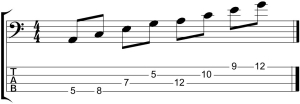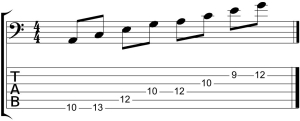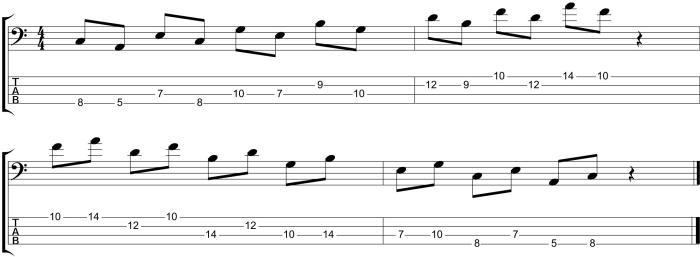In this lesson we’re going to to study the minor 7 chord quality. We’ll look at how its constructed, how to play it in different positions on the neck (in all keys), how to play it in different inversions and what extentions to add. There will also be some groove and solo studies for you to put this material to work in its proper musical setting.
So what is a minor 7 chord and where does it come from?
As with most chords the minor 7 occurs naturally in a number of diatonic scales. For now we’ll look at where it occurs in the Major scale. Figure 1 shows the C Major scale, if we play every other note starting with the second one we have the D minor 7 arpeggio, figure 2.
fig. 1

fig. 2

If we start on the third note of the Major scale and play every other note we have another minor 7 arpeggio, E minor 7. See figure 3.
fig. 3

Finally, if we start on the sixth note of the Major scale and play alternate notes we have one more minor 7 arpeggio, A minor 7. See figure 4.
fig. 4

Now we know that the Major scale contains three minor 7 chords, chords ii, iii, and vi, which means every Major key contains three minor 7 chords. Figure 5 shows one way you could practice minor 7 arpeggios through all 12 keys.
fig. 5
Practicing the arpeggios in this way really helps you learn the neck in an organised way.
Now that we know what the minor 7 looks and sounds like, lets look at a few more ways we can play it. Figures 6 through 9 show some different fingering possibilites for a one octave minor 7 arpeggio in A.
fig. 6

fig. 7

fig. 8

fig. 9

Figures 10 through 12 show a way we can play a two octave minor 7 arpeggio. On four string this requires a shift of position but five and six string players can play two octaves in one position. Figure 13 shows one way you could play a three octave Major 7 arpeggio on Six string.
fig. 10

fig. 11

fig. 12

fig. 13

As with the other lessons, these are not the only shapes you could or should use but they are the ones that make most sense to my hands, purely as an exercise. It goes without saying that good music doesn’t sound like technical exercises so you should aim to get comfortable with the other shapes (fig. 4 – 8). This way you’ll be confident you’re making the right note choices whatever position your fretting hand is in.
The next step is to play this material through all 12 keys. You’ll need to be confident in where every note is on the E and A strings (and B if you play Five or six string). If you already played the material from another arpeggio lesson through all 12 keys this should be straight forward. Below is a video of the minor 7 arpeggios in all 12 keys through the circle of fourths. Of course you could play round the circle of fifths or even chromatically if you like but make sure you hit every key.
Insert video
I always find it more fun to play a groove than an exercise so here are 12 grooves, one for each key. Its a good idea to play every groove in every key. Boom! 12 grooves just became 144.
C minor 7 groove

F minor 7 groove

Bb minor 7 groove

Eb minor 7 groove

Ab minor 7 groove

Db minor 7 groove

Gb minor 7 groove
B minor 7 groove

E minor 7 groove

A minor 7 groove

D minor 7 groove

G minor 7 groove

Inversions
What is an inversion?
So far we have played the minor 7 arpeggio in root position. This means that the root is the lowest note we play. We could also start with the third, fifth or seventh which we would call first, second or third inversion respectively. Here’s how a two octave A minor 7 arpeggio looks in first (figure 14), second (figure 15), and third (figure 16) inversion on four string bass.
fig. 14

fig. 15

fig. 16

As with the other arpeggios there are a couple of different ways you could practice this material through all 12 keys. The way I like to go is play all 12 root position arpeggios, then all 12 in first inversion, then second, then third. You could also play root position then first, second and third all in the same key before moving to the next key but the first way requires you to really know every note in a chord and where each chord tone is on the neck so you can shift to it. Below are the notes that make up the minor 7 arpeggios in every key.

Extensions
What is an extension?
Extensions are the notes beyond the 7th; the 9th, 11th, and 13th (sometimes refered to as the 6th).
With the minor 7 chord the extensions we use depends on the function of the chord within the key. Remember that there are three minor chords in any Major key and they are made by playing every other note from the second, third or sixth degree of the Major scale.
So lets say we are in the key of C Major and the chord is D minor 7, this would be chord ii-7. Figure 17 shows what that chord looks like with all extensions.
fig. 17

For our purposes we’ll call this the Dorian minor arpeggio as it shares its notes with the Dorian mode (mode ii) of the Major scale. The Dorian minor arpeggio has a Major 9th, an Eleventh and a Major Thirteenth.
Staying in the key of C, if we take the chord E minor 7, this would be chord iii-7. Mode iii of the Major scale is the Phrygian mode so we will call this chord the phrygian minor as they share the same notes. Play figure 18 to hear what this sounds like.
fig. 18

The Phrygian minor arpeggio has a minor 9th, sometimes called flat 9, an Eleventh, and a minor or flat thirteenth. These extensions add a pretty dark colour to this arpeggio which can sound cool but only if they are used functionally, i.e. when playing over chord iii- of the key or over a Phrygian vamp.
Finally we come to the arpeggio built on the sixth degree of the major scale. Since the mode starting on the sixth is called the Aeolian mode we will call this the Aeolian minor chord. Figure 19 shows this arpeggio starting on A which would put it in C Major again.
fig. 19

The Aeolian minor chord has a Major ninth, an Eleventh, and a minor or flat Thirteenth. The Aeolian is sometimes called the natural minor, it sounds a little more neutral than the Phrygian and a little less bright than the Dorian.
Remember that we have three different minor chords that function differently in a diatonic setting. They are NOT interchangeable on music that has a key centre however when playing modally or using this material for a one chord riff, pick the one that works best in the given situation.
What follows is a series of exercises to help you get the extended arpeggios down. Its a lot of information to digest as there are three unique minor arpeggios here. Playing patterns and exercises like this will get you started but try to use the material in a musical context as soon as possible. Below is a video of me jamming over a static minor 7 chord, see how I play a simple groove and then use the extended arpeggios to play a fill. {insert video}
The following exercise are in A minor. As always be sure to move the material through all 12 keys.
Figures 20 to 23 cover the dorian minor. Work through the exercises slowly until you’re comfortably playing it from memory then start moving through all twelve keys.
If you play a standard 20 fret four string bass you’re going to run out of notes in some keys. When this happens move the notes that are too high to the lowest playable position. You may find it doesn’t sound like the same key anymore, this is normal, just play a groove in the same key or put on a backing track to get the sound of the right key in your ear and then work through the material in this way. Its also helpful to always start from the root until you’re comfortable with how each inversion sounds.
fig. 20

fig. 21

fig. 22

fig. 23

Figures 24 to 27 are exercise for the Phrygian minor.
fig. 24

fig. 25

fig. 26

fig. 27

Figures 28 to 31 outline the Aeolian or Natural minor arpeggio.
fig. 28

fig. 29

fig. 30

fig. 31


